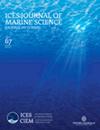黑线鳕(Melanogrammus aeglefinus)在乔治浅滩的空间分布取决于栖息地的密度选择和气候变暖
IF 3.4
2区 农林科学
Q1 FISHERIES
引用次数: 0
摘要
在不断变化的环境中,探测海洋鱼类空间分布的变化,了解气候变化和生物因素对鱼类分布影响的相对重要性,可以改善渔业管理。在过去十年中,乔治斯滩(GB)上的黑线鳕(Melanogrammus aeglefinus)数量大幅增加,达到历史最高水平,与此同时,该地区也出现了海洋温度极度升高的现象。本研究利用 50 年来在乔治滩春秋两季收集的底拖网调查数据,研究了黑线鳕可能的季节性和年际空间分布变化。利用空间、不同时间和时空自相关结构模型对这些数据进行了分析。为了描述黑线鳕空间分布的方向性变化,根据 Akaike 信息标准(AIC)选出的最佳模型估算了每个季节的重心(CG)和占位面积(AO)。结果表明,随着时间的推移,鱼类在春季和秋季的分布范围都有很大的扩展/收缩和分布变化。利用广义加法模型(GAM)评估了密度依赖性、年龄结构和气候变化在影响黑线鳕分布中的相对作用。研究发现,密度依赖性栖息地选择对两个季节的AO变化贡献最大,这与MacCall盆地模型理论一致。海洋温度的升高在形成秋季向北的分布转移中发挥了重要作用。GB 是黑线鳕在西北大西洋分布的南缘,根据气候模型预测,未来 50 年该区域将持续变暖,这将使 GB 与邻近的加拿大和美国国内管理区之间的种群边界难以确定。这将对黑线鳕的渔业管理产生影响。本文章由计算机程序翻译,如有差异,请以英文原文为准。
Density-dependent habitat selection and warming determine the spatial distribution of haddock (Melanogrammus aeglefinus) on Georges Bank
In an ever-changing environment, detecting shifts in the spatial distribution of marine fish and understanding the relative importance of climate change and biotic factors impacting fish distributions can improve fisheries management. Coincident with the significant increase in Haddock (Melanogrammus aeglefinus) abundance to a historically high levels on Georges Bank (GB) in the last decade, extreme ocean temperature increase was also observed in this region. In this study, the possible seasonal and inter-annual spatial distribution changes of haddock were investigated with >50 years of bottom trawl survey data collected in spring and fall on GB. These data were analyzed using models with spatial, different temporal, and spatio-temporal autocorrelation structures. To characterize the directional changes in haddock spatial distribution, the Center of Gravity (CG) and Area of Occupancy (AO) in each season were estimated from the best model selected by Akaike Information Criteria (AIC). The results showed substantial range expansion/contraction and distribution changes in both spring and fall over time. The relative role of density dependence, age structure, and climate change in affecting haddock distribution was evaluated using a generalized additive model (GAM). It was found that density-dependent habitat selection made the greatest contribution to the variations of AO in both seasons, which is consistent with the MacCall’s Basin model theory. Rising ocean temperatures played a major role in shaping a northward distribution shift in fall. GB is the southern edge of haddock distribution in the Northwest Atlantic, continued warming from climate model projections in the next 50 years in this region could make it difficult to define stock boundaries between GB and adjacent Canadian and US domestic management areas. This would subsequently impact fishery management of haddock.
求助全文
通过发布文献求助,成功后即可免费获取论文全文。
去求助
来源期刊

ICES Journal of Marine Science
农林科学-海洋学
CiteScore
6.60
自引率
12.10%
发文量
207
审稿时长
6-16 weeks
期刊介绍:
The ICES Journal of Marine Science publishes original articles, opinion essays (“Food for Thought”), visions for the future (“Quo Vadimus”), and critical reviews that contribute to our scientific understanding of marine systems and the impact of human activities on them. The Journal also serves as a foundation for scientific advice across the broad spectrum of management and conservation issues related to the marine environment. Oceanography (e.g. productivity-determining processes), marine habitats, living resources, and related topics constitute the key elements of papers considered for publication. This includes economic, social, and public administration studies to the extent that they are directly related to management of the seas and are of general interest to marine scientists. Integrated studies that bridge gaps between traditional disciplines are particularly welcome.
 求助内容:
求助内容: 应助结果提醒方式:
应助结果提醒方式:


